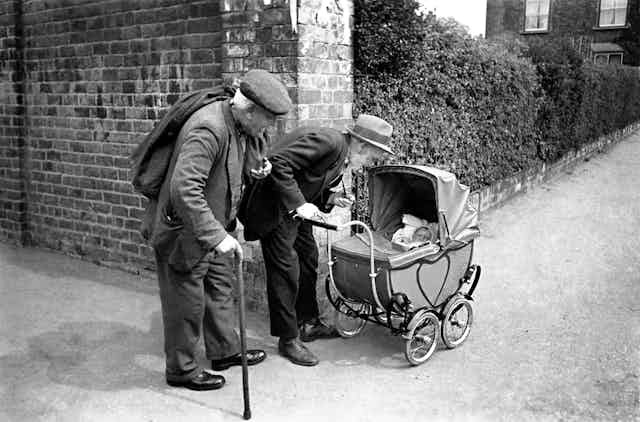On August 29 1938, in the build-up to the second world war, a now-defunct London newspaper asserted that Europe was tensely watching the crisis over Czechoslovakia unfold. But how could a newspaper know what a population was feeling? What if some people, even lots of people, were tensely watching “the racing news and daily horoscope”? This is the question posed by Mass-Observation at the start of the 1939 book, Britain.
Mass-Observation was established as a social movement in 1937 by Tom Harrisson, an ornithologist and self-taught ethnographer, surrealist poet and Daily Mirror journalist Charles Madge and Humphrey Jennings, a filmmaker and painter. Jennings didn’t last long. Three large male egos were probably at least one too many.
The trio were inspired by surrealism’s interest in coincidence and the unconscious, as well as by the Everyday Life in Middletown sociological studies being carried out in the US. And their output was an odd mix of science and poetry. It was also a democratic riposte to a newspaper and radio culture where the few communicated to the many: what would happen, they wondered, if the balance shifted the other way?
I first came across Mass-Observation while doing my doctoral research in the 1990s and became a trustee in 2022. That same year, coinciding with the project’s 85th anniversary, English Heritage installed a blue plaque at 6 Grotes Buildings in Blackheath, south London – the building in which it was conceived.
Predating the internet and social media by over half a century, this archive can be seen as an early form of collective content production or citizen ethnography. But unlike social media, Mass-Observers – as the project’s voluntary contributors are known – write with posterity in mind, and write at length, anonymously and with candour.
Candour and idiosyncrasies
The 1937 founding pamphlet describes Mass-Observation as an “anthropology of ourselves”. To this end, people were invited to volunteer to answer directives, to write diaries on specific days and to observe and describe the world around them.
Mass-Observation also established various projects – such as the Worktown project in Bolton – where paid observers took notes on activities in the street, in pubs and at football matches and local elections.
The first Mass-Observation material I worked on, in the 1990s, was a microfiche file entitled Bad Dreams and Nightmares. I was researching theories of everyday life. These accounts had been collated a few months before the start of the second world war, in an attempt to gauge social anxiety.
Reading about one or two nightmares can be banal. Reading the 66 reports that observers had sent in, however, had a cumulative effect of gnawing unease.

Ten years later, going through material that had been collected in the 1980s, I became obsessed with one woman’s response to a directive on housework. She had typed a 50-page report of two weeks of domestic routines. It was funny, beautifully written and deeply idiosyncratic. Uncertain about how long she had spent doing a chore and how long she had spent resenting the fact of doing the chore, she decides to use a stopwatch.
Early in the report, she was filled with self-doubt. She writes: “The trouble is I don’t like the way I am but it obviously doesn’t bother me enough to actually change my ways it just means that I have a constant low opinion of myself which I try to cover up by laughing about it.”
By the end of the report, she has had a family meeting to reallocate household work more fairly. It was practical feminism in action.
Archive of feelings
The first era of Mass-Observation stretched from the 1930s through the war (where the organisation worked with the UK government’s Ministry of Information) and into the postwar settlement and the building of the welfare state. By the mid-1950s, it had stopped using a national panel of voluntary writers and slowly shut up shop. Harrisson and Madge had long since gone on to other things.
Mass-Observation found a new lease of life in the mid-1970s when Harrisson bequeathed the archive to the University of Sussex, for safekeeping and public use. In 1981, a new generation of democratically minded academics got involved.
Inspired by oral history, second-wave feminism and the social sciences, they revived the national panel. About 700 volunteer writers were recruited. They would go on to write responses to directives about the Falklands conflict and Gulf wars, royal weddings, soap operas, gardening and electronic banking.
Every year for the last ten, as a nod to the 1937 book, Mass Observation Day Survey May 12, the organisation has asked the country at large to send in a diary for that same date.
During the first COVID lockdown, on May 12 2020, 5,000 accounts were sent in. These now form part of a significant collection of Mass Observation material generated about the pandemic, currently being mined by sociologists, geographers and those concerned with public health. It represents an invaluable archive for future historians.
You don’t go to the Mass-Observation archives to get a representative sample of opinion. It isn’t a Mori poll. You go to get at something being lived through: a sense of felt experience in all its particularity and peculiarity.
As detailed in the 1937 pamphlet, the original intention – and the one that still drives the project today – was that its voluntary writers would form “meteorological stations from whose reports a weather-map of popular feeling can be compiled”. Mass-Observation is a growing archive of feelings.

